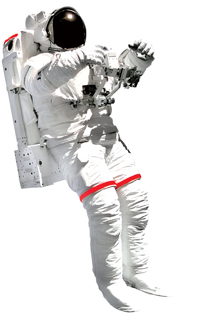the new space race
cover story
Who Will Take the Lead?
advanced than ever.
Who Will Take the Lead
?
advanced than ever.
As human exploration into space continues to advance forward, the dream of sending humans to colonize the moon, explore Mars, and travel beyond our solar system’s outermost reaches will soon become a reality. But instead of governments pioneering on this front, it may very well be private companies that lead the future into space flight. Indeed, while colonizing planets and travelling to far off galaxies may not be possible for quite some time, sending private citizens into suborbital space to take a snapshot of the earth from above may become a reality within the next year. In fact, with NASA partnering with private companies such as SpaceX and Blue Origin on projects based around the creation of reusable spacecrafts capable of carrying both payloads and human passengers to and from the International Space Station as well as other similar missions centered around sending humans into the deeper reaches above, the personal spaceflight industry may very well be on the verge of taking off.

One of the largest and most widely known private companies that has partnered with NASA is SpaceX, established in 2002 by Elon Musk with the ultimate goal of getting humans to Mars. In order to accomplish this goal in as efficient and cost-effective way as possible, SpaceX has been working on creating a new model of reusable rockets, and has already been quite successful to this end having already conducted over 20 test launches of reusable rockets into space without incident. While these rockets have been mainly used to carry payloads to and from the International Space Station as of yet, the recent test launch of the Dragon spacecraft in March of this year shows promise of sending Americans into space as early as this summer.
The recent test run of the Dragon—which was built with human transportation in mind and is equipped with software and hardware such as lasers and sensors designed to safely guide the spacecraft toward the ISS and autonomously dock itself onto a newly installed port specifically designed for the project—was met with solid success on its first run, and members of the ISS team were able to successfully enter the Dragon’s chamber without issue. And while the spacecraft has yet to transport an actual human subject, the successful transportation of a mannequin named Ripley bodes well for the eventual shuttling of humans this summer and beyond.
Another big contender in the private spaceflight arena is Virgin Galactic, known for their exorbitant spaceflight ticket prices capping off at $250 million per person for a 90-minute flight. Unlike SpaceX, however, Virgin Galactic isn’t concerned with colonizing Mars, but rather the creation of a whole new travel industry—suborbital tourism. And having presold over 600 tickets so far, Virgin Galactic is well on their way to launching and leading this futuristic industry, though a fatal crash during a test flight of their SpaceShipTwo model in 2014 may have set back their timeline by a few years.
However, while SpaceX may be preparing to send their version of a reusable rocket into space with human test subjects within the next few months, technically Virgin Galactic has already done so twice—though whether or not these passengers truly reached true outer space is up for debate. Reaching an altitude of nearly 56 miles above sea level, Virgin Galactic’s new SpaceShipTwo model VSS Unity flew higher than the Federal Aviation Administration’s definition of where space begins, but lower than another widely accepted boundary between Earth and space known as the Karman Line, which sets the boundary at somewhere around 62 miles above sea level. And while the three passengers onboard the VSS Unity described the Unity’s flight as high enough that they were able to see a black sky above them and the blue Earth below, the question still remains as to whether this journey was truly the first human flight by a private company into space.



Traditionally, many have prescribed to the boundary set by Hungarian physicist Theodore von Karman that the boundary between Earth’s atmosphere and space is roughly 62 miles above sea level, or around 100 kilometers. However, other entities such as the Federal Aviation Administration, U.S. Air Force and National Oceanic and Atmospheric Administration defining the boundary at 50 miles above sea level—and NASA’s mission control places this line at 76 miles above sea level, where atmospheric drag becomes noticeable. While a definition is necessary, no universally accepted formal definition has been adopted, an issue that will undoubtedly cause many problems for the private space tourism industry as it continues to develop, unless remedied soon.
Ultimately, whether or not a formal definition of the boundary between the Earth’s atmosphere and space can be agreed upon, and whether or not personal space flight finds major success within the next few months, the private space flight industry will undoubtedly continue to evolve in the years to come. With major companies such as SpaceX and Virgin Galactic—and other private entities such as Blue Origin and Orbital ATK—working continuously on ventures in privatized space flight, we are closer than ever before to finally sending not only trained astronauts, but also private citizens into space—and what was once a dream may soon become a reality.
About the author
Ana C. Rold is the Founder and Publisher of Diplomatic Courier magazine and the Editor-in-Chief of the G20, G7, and APEC Summit CAT Company publications. Rold teaches political science at Northeastern University and is the Host of The World in 2050–A Forum About Our Future. To engage with her on this article follow her on Twitter @ACRold.

